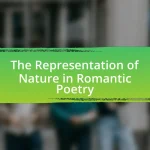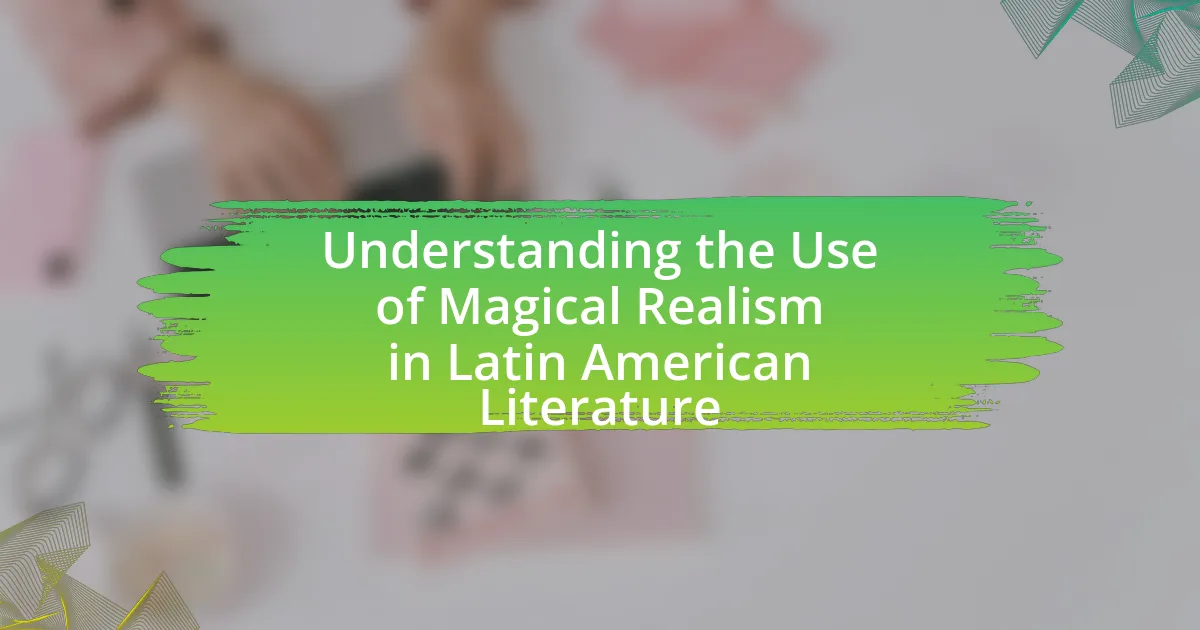The article examines the significant influence of mythology on contemporary storytelling, highlighting how archetypal characters, themes, and narratives derived from ancient myths resonate with modern audiences. It discusses the enduring relevance of mythological structures, such as the hero’s journey, in shaping character development and emotional engagement in literature and film. Key elements of mythology, including moral lessons and universal human experiences, are explored, along with the challenges and best practices for integrating these themes into modern narratives. The article emphasizes the cultural significance of mythology in fostering continuity and dialogue within contemporary society.
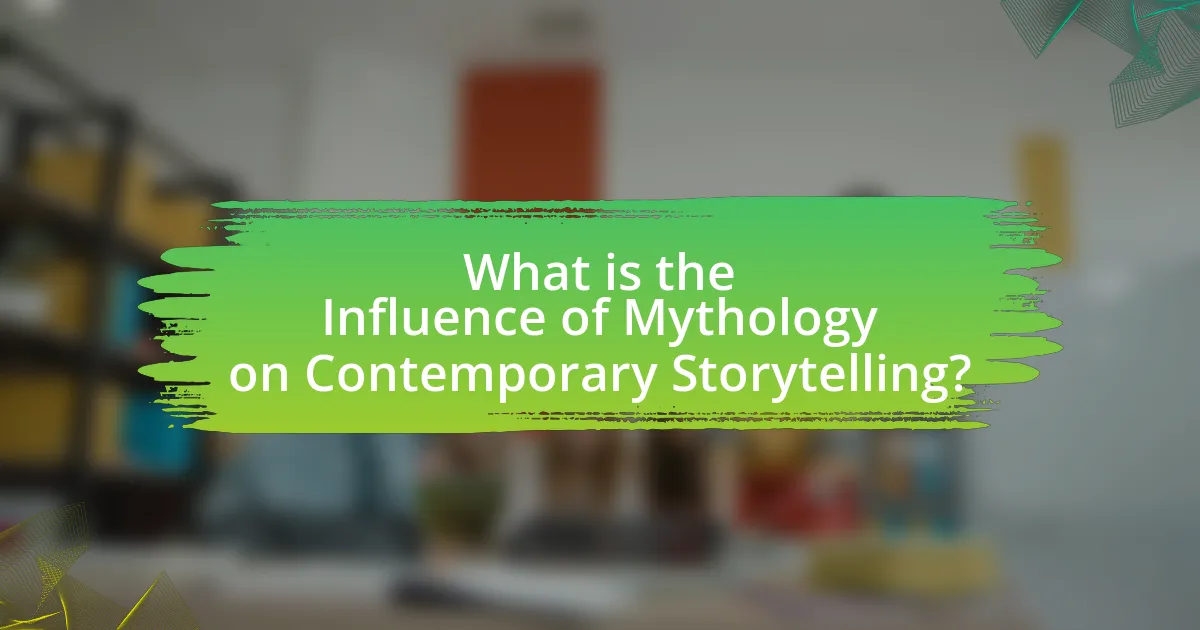
What is the Influence of Mythology on Contemporary Storytelling?
Mythology significantly influences contemporary storytelling by providing archetypal characters, themes, and narratives that resonate with audiences. These elements, such as the hero’s journey, are foundational in modern literature and film, as seen in works like “Star Wars,” which mirrors Joseph Campbell’s monomyth structure. Additionally, mythological motifs, such as creation myths and moral dilemmas, are prevalent in contemporary narratives, allowing storytellers to explore complex human experiences and cultural identities. This enduring relevance of mythology in storytelling is evidenced by the continued adaptation of ancient myths into modern contexts, demonstrating their power to shape and enrich contemporary narratives.
How has mythology shaped modern narratives?
Mythology has profoundly shaped modern narratives by providing archetypal characters, themes, and structures that resonate across cultures and time periods. For instance, Joseph Campbell’s concept of the “Hero’s Journey” illustrates how many contemporary stories, such as those in film and literature, follow a similar narrative arc found in ancient myths, highlighting the universal quest for identity and purpose. This framework is evident in popular works like “Star Wars” and “The Lord of the Rings,” which draw heavily on mythological elements to create compelling and relatable stories. Additionally, modern adaptations of myths, such as Rick Riordan’s “Percy Jackson” series, demonstrate how ancient tales can be reinterpreted to engage new audiences while preserving their core messages.
What are the key elements of mythology that persist in storytelling today?
Key elements of mythology that persist in storytelling today include archetypal characters, moral lessons, and the exploration of fundamental human experiences. Archetypal characters, such as heroes, mentors, and tricksters, are prevalent in modern narratives, reflecting universal traits and struggles. Moral lessons derived from mythological tales continue to shape ethical frameworks in contemporary stories, emphasizing themes like good versus evil and the consequences of one’s actions. Additionally, the exploration of fundamental human experiences, such as love, loss, and the quest for identity, remains central to storytelling, echoing the timeless themes found in ancient myths. These elements are evident in various forms of media, including literature, film, and television, demonstrating the enduring influence of mythology on modern storytelling.
How do archetypes from mythology appear in contemporary characters?
Archetypes from mythology manifest in contemporary characters through recognizable traits and narratives that resonate with audiences. For example, the hero’s journey, a common archetype, is evident in characters like Katniss Everdeen from “The Hunger Games,” who embodies the qualities of courage and resilience found in mythological heroes such as Hercules. Additionally, the archetype of the mentor appears in figures like Gandalf from “The Lord of the Rings,” paralleling mythological mentors like Merlin. These archetypes serve as foundational elements in storytelling, allowing modern narratives to connect with timeless human experiences and emotions, thereby reinforcing their relevance and relatability.
Why is mythology relevant in today’s storytelling?
Mythology is relevant in today’s storytelling because it provides timeless themes and archetypes that resonate with contemporary audiences. These narratives often explore fundamental human experiences such as love, conflict, and morality, which remain pertinent across cultures and eras. For example, Joseph Campbell’s concept of the “Hero’s Journey” illustrates how mythological structures influence modern narratives, as seen in popular films like “Star Wars” and “The Lord of the Rings.” This enduring relevance is supported by the fact that many successful stories draw on mythological elements to create relatable characters and compelling plots, demonstrating that mythology continues to shape the way stories are told and understood in the modern world.
What cultural significance does mythology hold in contemporary society?
Mythology holds significant cultural importance in contemporary society as it shapes narratives, values, and identities across various mediums. These ancient stories provide frameworks for understanding human experiences, moral dilemmas, and cultural heritage, influencing literature, film, and art. For instance, modern adaptations of Greek myths, such as in Rick Riordan’s “Percy Jackson” series, illustrate how these narratives resonate with contemporary themes of heroism and identity, making them relevant to today’s youth. Additionally, mythology serves as a source of inspiration for filmmakers like Guillermo del Toro, who incorporates mythological elements to explore complex themes in movies like “Pan’s Labyrinth.” This ongoing engagement with mythology underscores its role in fostering cultural continuity and dialogue, demonstrating its enduring relevance in shaping societal values and collective memory.
How does mythology enhance the emotional depth of modern stories?
Mythology enhances the emotional depth of modern stories by providing archetypal characters and universal themes that resonate with human experiences. These elements allow audiences to connect deeply with narratives, as they reflect fundamental aspects of life such as love, sacrifice, and the struggle between good and evil. For instance, Joseph Campbell’s concept of the “Hero’s Journey” illustrates how mythological structures underpin many contemporary tales, enabling characters to undergo transformative experiences that evoke empathy and emotional investment from the audience. This connection is further supported by the prevalence of mythological motifs in literature and film, which serve to evoke shared cultural memories and emotional responses, thus enriching the storytelling experience.
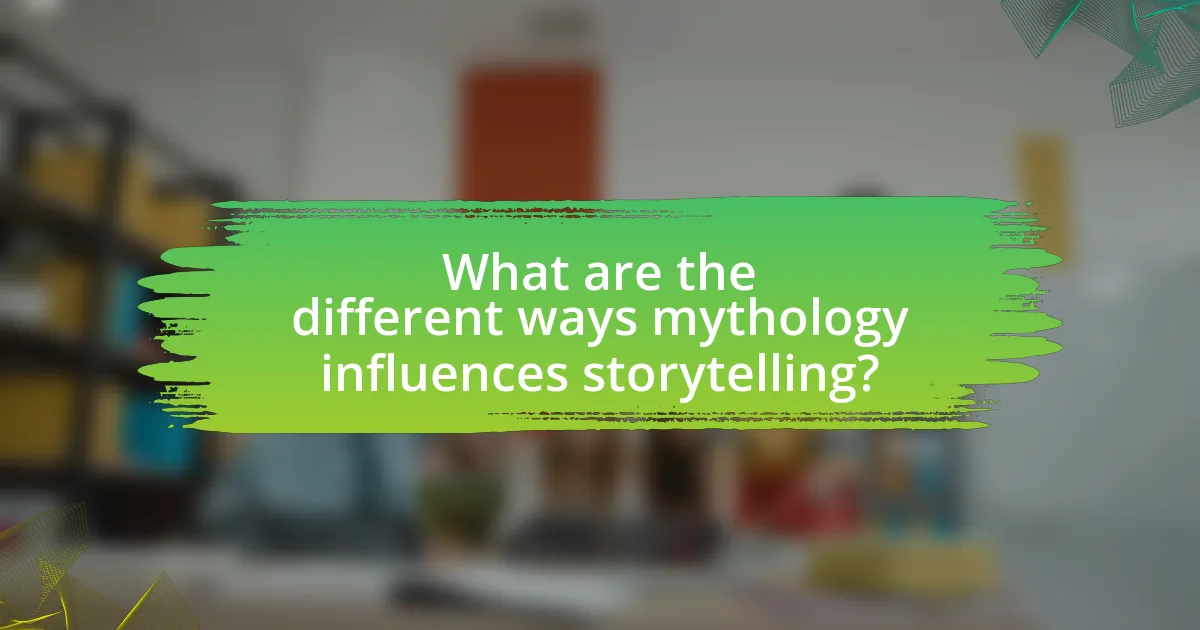
What are the different ways mythology influences storytelling?
Mythology influences storytelling in several key ways, including thematic inspiration, character archetypes, and narrative structure. Thematic inspiration arises as myths often explore universal human experiences such as love, conflict, and morality, which resonate in contemporary narratives. Character archetypes, such as the hero, mentor, and trickster, are derived from mythological figures, providing recognizable roles that enhance audience engagement. Additionally, narrative structures in storytelling frequently mirror mythological patterns, such as the hero’s journey, which outlines a protagonist’s adventure and transformation, as seen in works like Joseph Campbell’s “The Hero with a Thousand Faces.” These elements demonstrate how mythology serves as a foundational framework that shapes modern storytelling across various media.
How do authors incorporate mythological themes into their works?
Authors incorporate mythological themes into their works by using archetypal characters, motifs, and narratives that resonate with universal human experiences. For instance, many contemporary novels and films draw on the hero’s journey, a concept popularized by Joseph Campbell, which outlines a common narrative structure found in myths across cultures. This structure often includes stages such as the call to adventure, trials, and eventual transformation, allowing readers to connect deeply with the protagonist’s journey. Additionally, authors may reference specific myths or deities, weaving them into modern contexts to explore themes of identity, morality, and the human condition, as seen in works like Neil Gaiman’s “American Gods,” where various mythological figures interact in contemporary society. Such incorporation not only enriches the narrative but also provides a framework for exploring complex themes that resonate with audiences.
What techniques do writers use to blend mythology with modern themes?
Writers blend mythology with modern themes through techniques such as intertextuality, symbolism, and character archetypes. Intertextuality allows authors to reference or incorporate mythological stories and characters into contemporary narratives, creating a dialogue between the past and present. For example, Neil Gaiman’s “American Gods” intertwines various mythologies with modern American culture, illustrating how ancient beliefs persist in contemporary society. Symbolism is another technique, where mythological elements represent broader themes, such as the hero’s journey reflecting personal growth and societal challenges. Joseph Campbell’s concept of the monomyth highlights how these archetypal narratives resonate across cultures and eras, reinforcing their relevance today. Additionally, character archetypes derived from mythology, such as the hero, mentor, or trickster, are often reimagined in modern contexts, allowing readers to connect with timeless human experiences. This blending not only enriches storytelling but also emphasizes the enduring nature of myth in understanding contemporary issues.
How do visual media utilize mythological references in storytelling?
Visual media utilize mythological references in storytelling by incorporating archetypal characters, themes, and narratives that resonate with audiences on a subconscious level. For instance, films like “The Lion King” draw heavily from the myth of Osiris, using the hero’s journey and themes of resurrection and redemption, which are prevalent in various mythologies. This connection enhances emotional engagement and provides a framework for understanding complex human experiences, as supported by Joseph Campbell’s concept of the monomyth, or the hero’s journey, which outlines common patterns in myths across cultures. By embedding these mythological elements, visual media create relatable and timeless stories that reflect universal truths and cultural values.
What role do myths play in character development?
Myths play a crucial role in character development by providing archetypal frameworks that shape characters’ motivations, conflicts, and transformations. These archetypes, such as the hero, the mentor, or the trickster, serve as foundational templates that guide the audience’s understanding of characters’ journeys. For instance, Joseph Campbell’s concept of the Hero’s Journey illustrates how characters undergo specific stages, such as the call to adventure and the return, which resonate deeply with audiences and enhance emotional engagement. This connection to mythological structures not only enriches character depth but also allows for universal themes to emerge, making characters relatable across cultures and time periods.
How do mythological backgrounds shape character motivations?
Mythological backgrounds shape character motivations by providing archetypal frameworks that influence their desires, conflicts, and actions. Characters often embody traits or face challenges that reflect mythological themes, such as heroism, sacrifice, or vengeance, which are deeply rooted in cultural narratives. For instance, the hero’s journey, a common motif in mythology, drives characters to seek transformation and confront obstacles, as seen in modern stories like “The Lord of the Rings,” where Frodo’s quest mirrors the trials of mythic heroes. This connection to mythology not only enriches character depth but also resonates with audiences, as these familiar themes evoke shared cultural understandings and emotional responses.
What examples illustrate the impact of mythology on character arcs?
Examples illustrating the impact of mythology on character arcs include the transformation of characters like Harry Potter and Odysseus. In “Harry Potter,” Harry’s journey mirrors the hero’s journey archetype found in many mythologies, where he faces trials, gains allies, and ultimately confronts a dark force, reflecting Joseph Campbell’s monomyth structure. Similarly, Odysseus in Homer’s “The Odyssey” undergoes significant character development through his encounters with mythical beings and challenges, showcasing themes of perseverance and identity. These narratives demonstrate how mythological frameworks shape character growth and moral lessons, reinforcing the timeless relevance of mythology in storytelling.
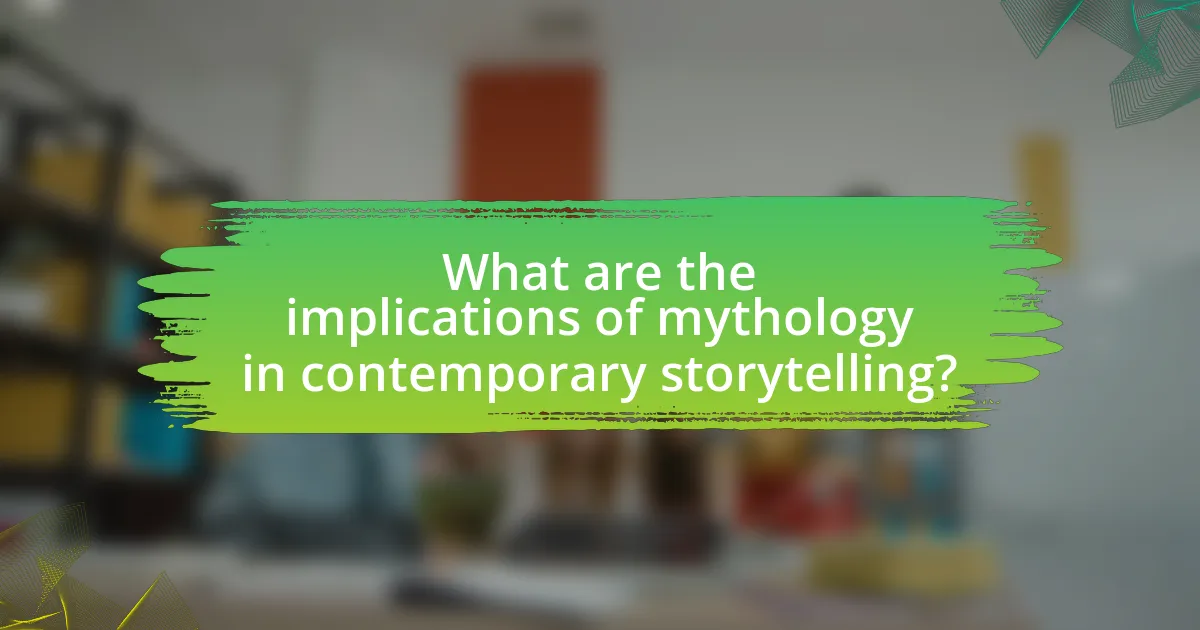
What are the implications of mythology in contemporary storytelling?
Mythology significantly influences contemporary storytelling by providing archetypal characters, themes, and narratives that resonate with audiences. These elements serve as a foundation for modern tales, allowing creators to explore complex human experiences through familiar mythic structures. For instance, Joseph Campbell’s concept of the “Hero’s Journey” illustrates how many contemporary narratives, such as those in film and literature, mirror ancient myths, thereby enhancing emotional engagement and relatability. This connection to mythology not only enriches storytelling but also fosters cultural continuity, as seen in adaptations of classic myths in modern contexts, such as the retelling of Greek myths in popular media like “Percy Jackson” and Marvel’s “Thor.”
How does mythology influence audience perception and engagement?
Mythology significantly influences audience perception and engagement by providing a framework of archetypes and narratives that resonate deeply with human experiences. These archetypes, such as the hero’s journey or the trickster, evoke emotional responses and foster connections between the audience and the story. For instance, Joseph Campbell’s concept of the monomyth illustrates how these universal themes in mythology can enhance relatability and immersion in contemporary storytelling. Research indicates that stories rooted in mythological elements can lead to increased audience investment, as they tap into shared cultural symbols and collective unconscious, making the narrative more compelling and memorable.
What psychological effects do mythological elements have on viewers?
Mythological elements have significant psychological effects on viewers, primarily by evoking deep emotional responses and facilitating personal identification with archetypal characters and narratives. These elements tap into universal themes such as heroism, morality, and the struggle between good and evil, which resonate with viewers’ own experiences and beliefs. Research by Joseph Campbell in “The Hero with a Thousand Faces” illustrates how mythological structures, like the hero’s journey, create a framework that helps individuals understand their own life challenges and aspirations. This connection can lead to increased empathy, self-reflection, and a sense of belonging within a larger narrative context.
How do audiences relate to mythological themes in modern narratives?
Audiences relate to mythological themes in modern narratives by recognizing universal archetypes and moral dilemmas that resonate with their own experiences. These themes often reflect fundamental human concerns such as identity, conflict, and transformation, which are prevalent in both ancient myths and contemporary stories. For instance, Joseph Campbell’s concept of the “hero’s journey” illustrates how modern protagonists often mirror mythological heroes, allowing audiences to connect emotionally and intellectually with their journeys. This connection is further supported by research indicating that narratives incorporating mythological elements can enhance engagement and empathy, as seen in studies published in the Journal of Communication, which highlight the effectiveness of storytelling in conveying complex ideas through familiar mythic structures.
What challenges do storytellers face when integrating mythology?
Storytellers face several challenges when integrating mythology, primarily including cultural sensitivity, audience familiarity, and narrative coherence. Cultural sensitivity is crucial as myths often carry deep cultural significance; misrepresentation can lead to offense or misunderstanding. Audience familiarity poses a challenge because not all audiences may have the same level of knowledge about specific myths, which can affect engagement and comprehension. Narrative coherence is also essential, as blending mythological elements with contemporary themes requires careful crafting to maintain a cohesive story that resonates with modern audiences while respecting the original mythological context. These challenges necessitate a thoughtful approach to ensure that the integration of mythology enhances rather than detracts from the storytelling experience.
How can cultural sensitivity be maintained when using mythological references?
Cultural sensitivity can be maintained when using mythological references by thoroughly researching the cultural context and significance of the myths being referenced. Understanding the origins, meanings, and contemporary interpretations of these myths ensures respectful and accurate representation. For instance, using Native American mythology requires awareness of the diverse tribes and their unique stories, as misrepresentation can perpetuate stereotypes and cultural appropriation. Engaging with cultural experts or community members can provide insights that enhance authenticity and respect. This approach not only honors the source material but also fosters inclusivity and understanding in storytelling.
What pitfalls should writers avoid when adapting myths for modern audiences?
Writers should avoid oversimplifying complex mythological themes when adapting myths for modern audiences. Simplification can strip away the rich cultural and philosophical nuances that give myths their depth and relevance. For instance, many myths explore intricate moral dilemmas and human experiences that resonate across time; reducing these to mere entertainment can alienate audiences seeking substance. Additionally, writers must be cautious of cultural appropriation, which can occur when they borrow elements from a culture without understanding or respecting its context. This can lead to misrepresentation and offense, undermining the integrity of the original myth. Lastly, failing to update the language and context appropriately can make the adaptation feel outdated or irrelevant, as modern audiences may struggle to connect with archaic expressions or settings.
What best practices can enhance the use of mythology in storytelling?
Integrating mythology into storytelling can be enhanced by employing several best practices. Firstly, understanding the cultural context of the myths ensures authenticity and relevance, as myths often reflect the values and beliefs of the societies from which they originate. For example, Joseph Campbell’s concept of the “monomyth” or hero’s journey illustrates how many narratives share common structures rooted in mythology, making them relatable across cultures.
Secondly, blending mythological elements with contemporary themes can create a compelling narrative that resonates with modern audiences. This approach allows for the exploration of timeless human experiences while addressing current societal issues. For instance, Neil Gaiman’s “American Gods” effectively merges ancient mythologies with contemporary American culture, demonstrating how these stories can evolve and remain impactful.
Lastly, character development that draws on archetypal figures from mythology can deepen emotional engagement. Carl Jung’s theories on archetypes highlight how these universal symbols can evoke strong responses from audiences, making characters more relatable and memorable. By utilizing these best practices, storytellers can effectively harness the power of mythology to enrich their narratives.
How can writers effectively research and incorporate mythology into their narratives?
Writers can effectively research and incorporate mythology into their narratives by utilizing a variety of scholarly resources, including academic texts, online databases, and cultural studies. Engaging with primary sources, such as ancient texts and folklore, allows writers to understand the original context and themes of the myths. For example, studying Joseph Campbell’s “The Hero with a Thousand Faces” reveals the universal patterns in mythological storytelling, which can be applied to modern narratives. Additionally, analyzing how different cultures interpret similar myths can provide depth and diversity to a writer’s work, as seen in the comparative studies of myths by authors like Robert Graves. By synthesizing this information, writers can create rich, layered narratives that resonate with contemporary audiences while honoring the original mythological sources.
What strategies can be employed to create original stories inspired by mythology?
To create original stories inspired by mythology, one effective strategy is to reinterpret existing myths by placing them in contemporary settings or contexts. This approach allows for the exploration of timeless themes such as heroism, morality, and the human condition while making them relatable to modern audiences. For example, the ancient Greek myth of Persephone can be reimagined as a story about personal growth and empowerment in a contemporary urban environment, reflecting current societal issues like gender roles and mental health.
Another strategy involves blending elements from multiple mythologies to create a unique narrative. By combining characters, themes, or motifs from different cultural myths, writers can craft original stories that celebrate diversity and highlight universal truths. For instance, merging the Norse concept of Ragnarok with the Hindu cycle of creation and destruction can yield a rich narrative exploring the cyclical nature of existence.
Additionally, incorporating personal experiences or cultural backgrounds into mythological frameworks can lead to original storytelling. This method allows writers to infuse their narratives with authenticity and emotional depth, making the mythological elements resonate more profoundly with readers. By grounding mythological themes in personal or cultural contexts, stories can achieve a fresh perspective while honoring their mythological roots.

